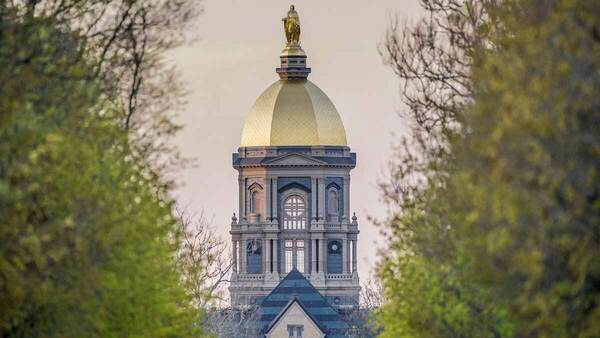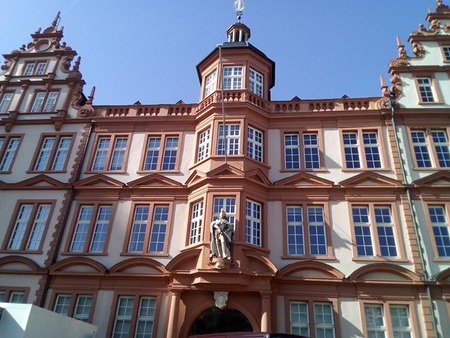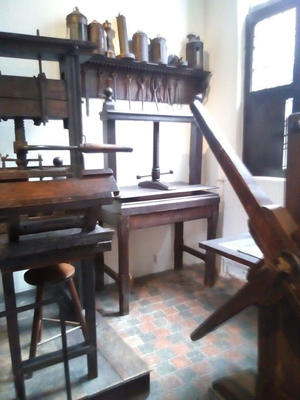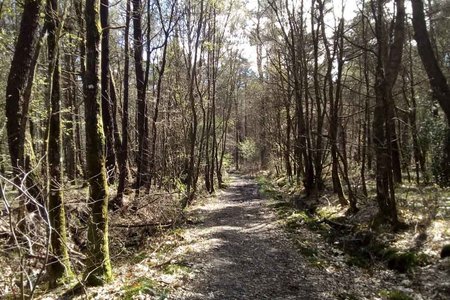
Joan Becker, a junior Program of Liberal Studies major, recently visited France, Germany, and Belgium to conduct research for her senior project, which will involve creating a handmade, illustrated book about King Arthur. Her Nanovic-supported research trip allowed her to learn about the history European bookmaking and view, in person, the places and scenery she plans to write about in her book.
“Through this experience, I've gained so much valuable information and inspiration for my senior thesis project. I will always value this memorable experience, but it is just one special component of the resources I've been able to access through the Nanovic Institute, from research advice to lectures to cultural events.”
I proposed a trip to three locations in Europe in order to conduct research for my senior thesis: the Gutenberg Museum in Mainz, Germany; the Plantin-Moretus Museum in Antwerp, Belgium, and the Paimpont Forest in France. At the first two locations, I researched the history of bookmaking, and got the chance to view rare books in person. At the last location, I conducted visual research (gathering reference images for visual art) of the Paimpont Forest, traditionally associated with the Broceliande Forest of Arthurian romance. Both of these endeavors contributed significantly to my senior thesis project, in which I will produce a hand-printed, hand-bound book, in imitation of early printed incunabula.
 The Guttenberg Museum
The Guttenberg Museum
At these museums, I was able to conduct research that was much more explorative and comprehensive than what I would be able to do simply through books or internet research, observing a wide range of original early modern books, as well as the equipment used to produce them. As for the visual research in France, I needed to visit the forest in person because some of the action of my thesis book will be set in that area. It was important for me to gather my own reference images so that I could make accurate illustrations without working from the copyrighted images of other photographers; this way, my work remains my own, and I am free to publish it if I get the chance. Furthermore, the Paimpont area is not heavily travelled, so the range of available images of that landscape is very limited.
Learning book creation of the past
The extensive collections of manuscripts, printed books, and printed illustrations held by the Gutenberg Museum and the Plantin Moretus Museum gave me a profound insight into the experimentation and innovation that took place in the first century of European book-printing, giving me an idea of historically-accurate approaches to book creation that I could take within my project. Now I have a detailed idea of the processes that produced these books, the environments in which their creators worked, and the rhythms of those bookmakers' daily lives.
 Printing equipment in Plantin Moretus Museum
Printing equipment in Plantin Moretus Museum
Furthermore, learning about the history of the book at those locations gave me a unique head-start on a tutorial I am taking this semester at Oxford (where I am studying abroad), studying the history of the book with the Librarian Fellow of New College.
Johannes Gutenberg and Christophe Plantin loom very large as influential figures within the history of the book, and it was so special to be able to visit the places where they lived and worked. I now have personal memories of a range of rare books--some of which would rarely be mentioned in student books or academic writing on the topic--which I can reference and analyze within this tutorial. So I have already begun to reap the benefits of this trip, even before beginning my senior thesis project! But most importantly, I am looking forward to incorporating all this learning into the project itself.
Witnessing the beauty of Brittany
Visiting Paimpont was also a transformative experience. I was able to view beautiful chateaus and a magnificent medieval abbey in the heart of Brittany, in a little-travelled area that is nevertheless crucial to the Arthurian literature which inspires me. I was able to gather a large number of photographs of the landscape, detailed photographs of local flora to incorporate into my illustrations, and a number of sketches.
I have already conducted similar research in northern Wales, which will also feature in my book as another "Arthurian location", but hiking in the Paimpont area was a strikingly different experience, and I am excited to incorporate this diversity of landscape into my final project.
Additionally, much like with my history of the book tutorial, I have already begun to enjoy the memories of Paimpont in relation to my studies, as I am also taking a tutorial on Arthurian literature in Oxford this semester. Just this week, I studied the romances of Chretien de Troyes, who mentions Broceliande (the Paimpont Forest) throughout his narratives. I was excited to tell my tutor that I had just visited the area, and had seen the now-rare Breton language on the signs for businesses and local landmarks.
Appreciating unexpected surprises
 Paimpont Forest
Paimpont Forest
Overall, the trip was a success. There were many pleasant surprises that do not necessarily relate to the content of my project, but were very special to view as an artist and a student of European culture through much of the PLS curriculum.
I got to visit the church of St. Stephen, which holds some stained-glass windows from Mark Chagall, an artist whom I admire very much. I was able to see some historic German architecture, most notably the beautiful hilltop citadel of Mainz, and also the ruins of a Roman amphitheater, from Mainz's days as a Roman settlement.
In Antwerp, I was able to see the beautiful Guild Houses from the city's prosperous past, and see a range of painted altarpieces which were on display in Our Lady's Cathedral--as well as some paintings by Rubens! I also visited MHKA, the Museum of Contemporary Art in Antwerp, an award-winning art museum whose collections offered a nice contrast to the wealth of historical art I got to see on the trip.
There were fewer surprises in France (though there was plenty of beautiful nature!), but I was able to see the historic city of Rennes, which I passed through on my way to and from Paimpont.